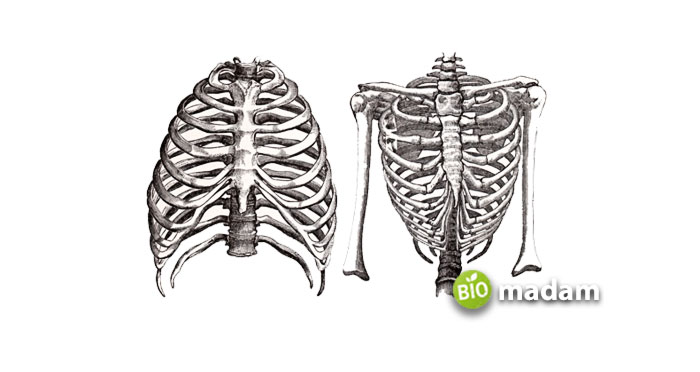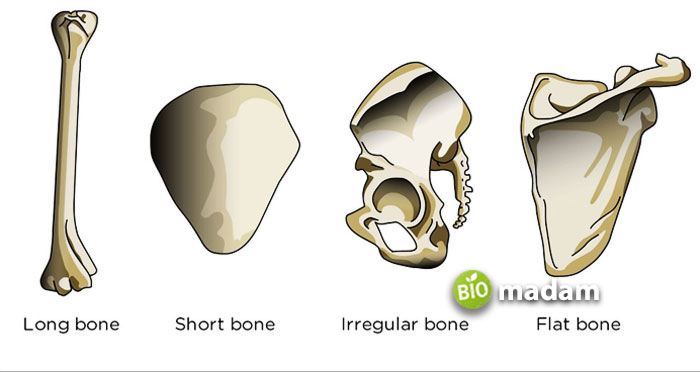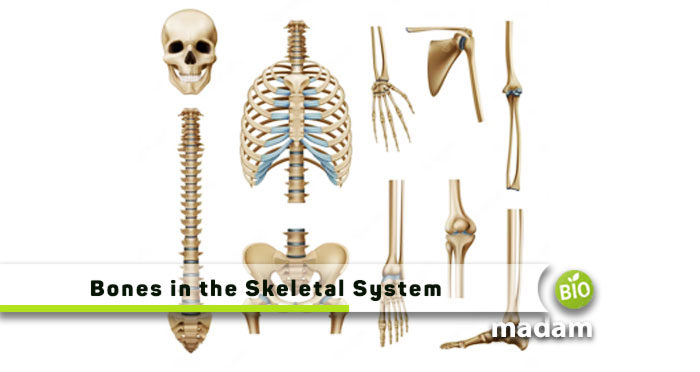Different habitats reside in an ecosystem comprising vertebrates and invertebrates. Human beings are named vertebrates because these large organisms have a backbone, a spinal column, and an entire skeletal system. We, as humans, have complex anatomy and physiology to provide a proper shape to the body. All organs work side by side and are surrounded by a framework of bones.
Continue reading the article to understand more about the skeletal system and the functions of bones.
What is a Skeletal System?
An essential foundation of a body that provides an appropriate structure and allows body movements is called a skeletal system. The hand that you move, the neck that can be turned around to a maximum angle, and the knees that you bend – all are due to the connection of muscles to bones in a skeletal system. This interlinking of the muscles to bones gives it another name, called the musculoskeletal system.
A skeletal system consists of bones, cartilage, and connective tissues, like tendons and ligaments. All these structures combine to create a network that shields the organs and also stores minerals. Bones, being the most primitive part of a skeletal system, have several essential functions.

What is a Bone?
Bones are rigid but elastic connective tissues. These living tissues are surrounded by a mineralized matrix, having an outer covering called the periosteum. Many muscles, ligaments, and tendons are often attached to the periosteum. The principal components that separate a bone from other hard tissues are calcium phosphate and collagen. All types of bones have an exterior and interior layer. The outer one is called the cortex, which is compact and smooth and has variable thickness depending upon the type. However, the interior of a bone is arranged in a network, where the blood and lymphatic vessels run to provide nourishment to a bone.
A human skeleton typically has 206 bones, of which 80 are axial, whereas 126 are appendicular. Axial bones have five parts, including the skull bone, hyoid bone, ribcage, small bones in the middle ear, and vertebra. Similarly, appendicular bones embrace the hands, arms, legs, ankles, hips, shoulders, etc.
Functions of Bones in a Skeletal System
A human body is incomplete without a skeletal system containing bones. Each bone provides a specific shape and strength to that particular part of a body, thus these connective tissues maintain overall health and well-being. Some of the key functions include:

Providing Complete Support
Your entire skeleton is due to the connection of bones that is holding it together. Thus, bones are responsible for developing the body’s framework by supporting its weight and regulating its shape; for example, a vertebral column supports the head and trunk. Similarly, leg and hip bones hold your weight while you’re standing, walking, or running.
Helps Facilitate Body Movements
Bones naturally work along the muscles to provide voluntary movements to a body. The muscles are attached to bones via tendons, so when a muscle contracts, the bones connected to it move. All these connections are interlinked through joints. Another important aspect is that besides the movement, this linking of bones, muscles, and joints protects the internal organs and their surrounding tissues.
Protection of Organs
As discussed above, bones are directly liable to protect internal organs. There are numerous examples to check if bones protect organs or not. For example, the skull protects the brain throughout your life. Similarly, a ribcage consists of a pair of 12 bones to guard your heart and both lungs. In addition, the vertebrae encircle your spinal cord.
Production and Maintenance of Blood cells
Bones function to continue a process in the body called hematopoiesis, which occurs in the red bone marrow. Sternum, ribs, and pelvis are the types of bones responsible for producing a number of cells from the bone marrow, including red blood cells, white blood cells, and platelets.
Site of Storage
Bones serve as a storage site for several minerals, e.g., magnesium, calcium, and phosphorus. These minerals, with vitamins and proteins, perform various essential functions, such as nerve function, muscle contraction, and blood clotting.
Helps Maintain pH Balance
Another critical role of bones is to regulate the body’s pH. Bones actively release alkaline salts, such as calcium phosphate, in the blood and plasma to maintain their pH. According to a theory, when a human body is not getting adequate buffering from the diet, the skeleton system naturally standardizes the body pH between 7.35 and 7.45.
What are the Main Types of Bones?
Different types of bones create a framework for structural strength and support in a body. You will encounter five main types of bones. These are:
- Long Bones: As the name indicates, long bones are wide and long, found in hands, arms, legs, and feet. These are dense and hard, with a shaft and two ends. Common examples include the humerus (upper arm bone) and femur (thigh bone).
- Short Bones: Again, as the name says, short bones are roughly the shape of a cube. These are always equal in length, width, and thickness. You can check the wrists and ankles as they comprise short bones. Furthermore, these are made up of spongy bones covered with a layer of compact bones. Short bones are found only in the carpals of wrists and the tarsals of ankles.
- Sesamoid Bones: These bones are embedded in the tendons and are round in shape. Sesamoid bones are located in areas where there is stress or pressure applied, such as knees or feet. The largest sesamoid bone present in the body is the “patella or kneecap.”
- Flat Bones: Another type of bone is the flat bone, which is made up of spongy bones embedded in compact bones. These are thin, flat, and a little curved in shape. The ribs, skull, sternum, and scapulae; all comprise flat bones essential in protecting the parts.
- Irregular Bones: These comprise unique shapes, so are named irregular bones. As the name signifies, irregular bones do not fit in any of the above categories. These are found in the pelvis, vertebrae, and sphenoid.

Types of Bone Cells
Three main types of bone cells contribute to the proper functioning of bones. These are osteoblasts, osteoclasts, and osteocytes.
- Osteoblasts: These are the cells responsible for synthesizing and depositing new bone tissues. Osteoblasts produce the bone matrix, consisting of collage fibers and other proteins, and further mineralize it to maintain the rigid structure.
- Osteoclasts: These bone cells are also called bone-resorbing cells. Osteoclasts are responsible for breaking down or remodeling old and damaged bone tissues. The entire process is held by the secretion of various enzymes.
- Osteocytes: Another name for osteocytes is mature bone cells. These cells are embedded within the mineralized matrix of the bone tissues and manage the local mineral deposition. Furthermore, osteocytes detect mechanical stress and strain on the bone and signal the brain to make adjustments and repair it as needed.
The Bottom Line
The bones might seem simple, but their role in the skeletal system is relatively complex. Due to its various functions, from providing support and protection to maintaining the body’s pH, it is considered an essential component of anatomy and physiology. Slight changes in the bone structure can result in fractures and sprains. Similarly, numerous diseases and disorders associated with bone, such as osteoporosis, rheumatoid arthritis, osteoarthritis, etc., are observed.
FAQs
What is the importance of bone?
Bones hold great significance in the skeletal system; and thus, in the human body. These function to support and protect the internal body organs, such as the heart and brain. Moreover, bones allow a person to move; hence, it is of high importance.
What is the smallest bone in a body?
The stapes is the smallest bone in the body that is sometimes also called “stirrup.” It is present in the innermost layer of an ear. These bones primarily function to conduct sound from a membrane to the middle ear.
Why do babies have 306 bones?
Newborn babies have naturally more cartilage than an adult. So there are almost 306 bones in a newborn. As they grow up, the cartilage turns to bones through a process called ossification. And by the end, an adult human body is observed to have 206 bones.
Which is more serious, osteoarthritis or rheumatoid arthritis?
Although these two conditions seem similar, they still vary in root causes and treatments. Osteoarthritis is limited to affecting the joints, being a degenerative disease. However, contrary to osteoarthritis, rheumatoid arthritis is more complex and has more signs and symptoms due to being an autoimmune disorder.
Does acidity affect bones?
The acidity in a body can indirectly affect a bone. As we know, osteoblasts and osteoclasts are the types of bone cells, and increased acidity alters osteoclast activity. Hence, this interlinking is a risk factor for developing osteoporosis.

Anna has completed her degree in Pharmacy from the University of Hawaii. She is serving as a research assistant in a pharmaceutical company. She had a great interest in writing blogs, traveling to different parts of the US, and trying delicious recipes in her spare time.

